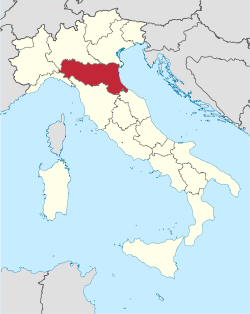This article's factual accuracy may be compromised due to out-of-date information. (April 2023) |
Emilia-Romagna
| |
|---|---|
|
| |
 | |
| Country | Italy |
| Capital | Bologna |
| Government | |
| • President | Michele De Pascale (PD) |
| Area | |
• Total | 22,446 km2 (8,666 sq mi) |
| Population (2010-11-30) | |
• Total | 4,446,220 |
| • Density | 200/km2 (510/sq mi) |
| Demonyms |
|
| GDP | |
| • Total | €163.293 billion (2021) |
| Time zone | UTC+1 (CET) |
| • Summer (DST) | UTC+2 (CEST) |
| ISO 3166 code | IT-45 |
| NUTS Region | ITH[2] |
| HDI (2022) | 0.940[3] very high · 1st of 21 |
| Website | www |
Emilia-Romagna (UK: /ɪˌmiːliə roʊˈmɑːnjə/, US: /eɪˌ-/, both also /ɛˌ-/,[4][5][6][7] Italian: [eˈmiːlja roˈmaɲɲa]; Emilian: Emégglia-Rumâgna or Emîlia-Rumâgna; Romagnol: Emélia-Rumâgna) is an administrative region of northern Italy, comprising the historical regions of Emilia and Romagna. Its capital is Bologna. It has an area of 22,446 km2 (8,666 sq mi), and a population of 4.4 million.
Emilia-Romagna is one of the wealthiest and most developed regions in Europe, with the third highest gross domestic product per capita in Italy. It is also a cultural center, being the home of the University of Bologna, the oldest university in the world. Some of its cities, such as Modena, Parma, Ferrara, and Ravenna, are UNESCO heritage sites. It is a center for food and automobile production (such as Ferrari, Lamborghini, and Maserati). It has coastal resorts such as Cervia, Cesenatico, and Rimini. In 2018, the Lonely Planet guide named Emilia-Romagna as the best place to see in Europe.[8]
- ^ "Population on 1 January by age, sex and NUTS 2 region", www.ec.europa.eu
- ^ Commission Regulation (EU) 2016/2066 of 21 November 2016 amending the annexes to Regulation (EC) No 1059/2003 of the European Parliament and of the Council on the establishment of a common classification of territorial units for statistics (NUTS)
- ^ "Sub-national HDI - Area Database - Global Data Lab". hdi.globaldatalab.org. Retrieved 5 March 2023.
- ^ "Emilia-Romagna". The American Heritage Dictionary of the English Language (5th ed.). HarperCollins. Retrieved 6 May 2019.
- ^ "Emilia-Romagna". Collins English Dictionary. HarperCollins. Retrieved 6 May 2019.
- ^ "Emilia-Romagna". Lexico UK English Dictionary. Oxford University Press. Archived from the original on 27 May 2022.
- ^ "Emilia-Romagna". Merriam-Webster.com Dictionary. Merriam-Webster. Retrieved 6 May 2019.
- ^ Planet, Lonely. "10 best places to visit in Europe in 2019". Lonely Planet.

